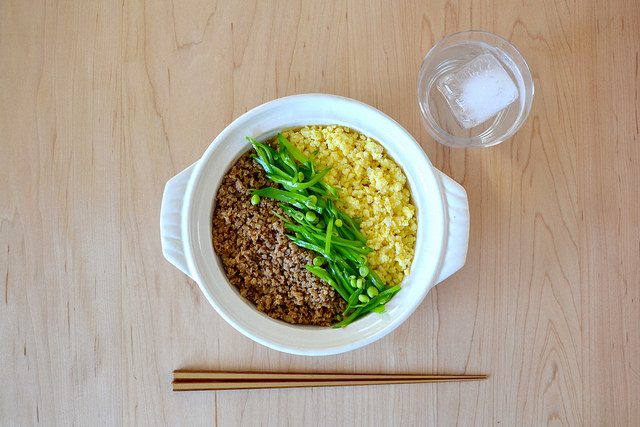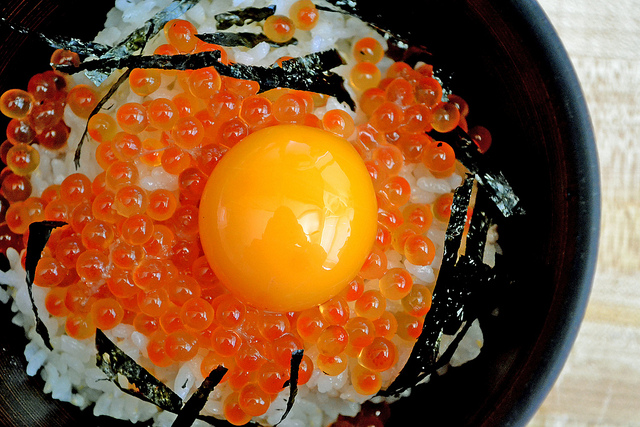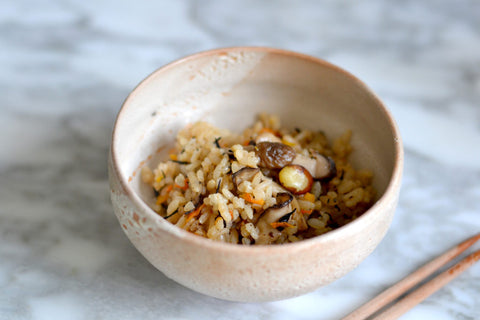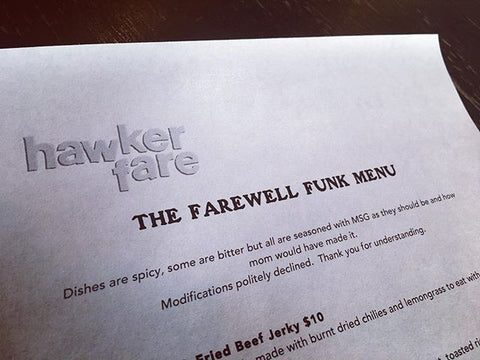
If you've ever cooked Japanese food, you know that mirin, or sweet cooking sake, is an integral ingredient. Whether you use it in dressings, sauces, marinades, or stews, this clear, golden-hued rice wine adds both umami and sweetness. Japanese cooks also use it to add viscosity, richness, and gloss to food, as well as temper fishy or gamey flavors. A good mirin can really elevate a dish. Mirin is made by fermenting koji, sweet rice, and shochu for three to six months. But not all mirins are the same. If you've bought mirin before, you may notice that a lot of the bottles found in markets are labeled
"aji-mirin." Aji-mirin is made with added salt and sweeteners and is usually lower in alcohol. As the
New York Times explains, "it is to real mirin what a cooking wine is to a fine varietal." With real mirin, or
hon-mirin, the sweetness is derived from the fermentation process.
Takara Mirin is a hon-mirin. Clocking in at 12% ABV, Takara Mirin is made with premium rice. Its umami flavors comes from its naturally occurring amino acids, which give it a more rich ricey flavor than you'd get from aji-mirin. The same New York Times article I quote above says Takara Mirin "is deliciously complex, with overtones of sake." Not sure what to make mirin? We've got a whole host of recipes on the blog, especially Yoko's Japanify dishes. Pick up a copy of
Japanify All Day, our cooking zine, or peruse the
Japanify recipes online. To make it easy for you, here are 5 recipes that use mirin:
 Kasuzuke Salmon
Kasuzuke Salmon Soboro Donburi
Soboro Donburi Hot Soba with Simmered Herring
Hot Soba with Simmered Herring Ikura Don
Ikura Don Nikujaga
Nikujaga
 If you've ever cooked Japanese food, you know that mirin, or sweet cooking sake, is an integral ingredient. Whether you use it in dressings, sauces, marinades, or stews, this clear, golden-hued rice wine adds both umami and sweetness. Japanese cooks also use it to add viscosity, richness, and gloss to food, as well as temper fishy or gamey flavors. A good mirin can really elevate a dish. Mirin is made by fermenting koji, sweet rice, and shochu for three to six months. But not all mirins are the same. If you've bought mirin before, you may notice that a lot of the bottles found in markets are labeled "aji-mirin." Aji-mirin is made with added salt and sweeteners and is usually lower in alcohol. As the New York Times explains, "it is to real mirin what a cooking wine is to a fine varietal." With real mirin, or hon-mirin, the sweetness is derived from the fermentation process. Takara Mirin is a hon-mirin. Clocking in at 12% ABV, Takara Mirin is made with premium rice. Its umami flavors comes from its naturally occurring amino acids, which give it a more rich ricey flavor than you'd get from aji-mirin. The same New York Times article I quote above says Takara Mirin "is deliciously complex, with overtones of sake." Not sure what to make mirin? We've got a whole host of recipes on the blog, especially Yoko's Japanify dishes. Pick up a copy of Japanify All Day, our cooking zine, or peruse the Japanify recipes online. To make it easy for you, here are 5 recipes that use mirin:
If you've ever cooked Japanese food, you know that mirin, or sweet cooking sake, is an integral ingredient. Whether you use it in dressings, sauces, marinades, or stews, this clear, golden-hued rice wine adds both umami and sweetness. Japanese cooks also use it to add viscosity, richness, and gloss to food, as well as temper fishy or gamey flavors. A good mirin can really elevate a dish. Mirin is made by fermenting koji, sweet rice, and shochu for three to six months. But not all mirins are the same. If you've bought mirin before, you may notice that a lot of the bottles found in markets are labeled "aji-mirin." Aji-mirin is made with added salt and sweeteners and is usually lower in alcohol. As the New York Times explains, "it is to real mirin what a cooking wine is to a fine varietal." With real mirin, or hon-mirin, the sweetness is derived from the fermentation process. Takara Mirin is a hon-mirin. Clocking in at 12% ABV, Takara Mirin is made with premium rice. Its umami flavors comes from its naturally occurring amino acids, which give it a more rich ricey flavor than you'd get from aji-mirin. The same New York Times article I quote above says Takara Mirin "is deliciously complex, with overtones of sake." Not sure what to make mirin? We've got a whole host of recipes on the blog, especially Yoko's Japanify dishes. Pick up a copy of Japanify All Day, our cooking zine, or peruse the Japanify recipes online. To make it easy for you, here are 5 recipes that use mirin:  Kasuzuke Salmon
Kasuzuke Salmon Soboro Donburi
Soboro Donburi Hot Soba with Simmered Herring
Hot Soba with Simmered Herring Ikura Don
Ikura Don Nikujaga
Nikujaga




Comments (0)
There are no comments for this article. Be the first one to leave a message!